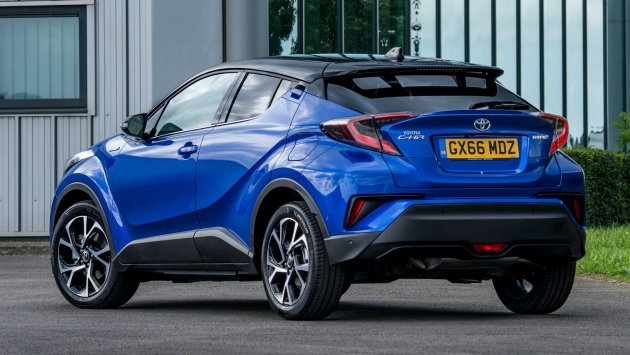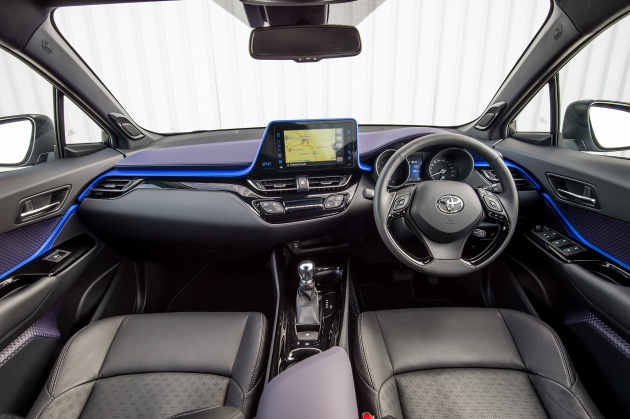
If you ever wanted an in-depth look at the all-new Toyota C-HR, you’ve come to the right place as the company has released some 100 or more images of its compact crossover, which first made its global debut back in March this year.
Built on the modular Toyota New Global Architecture (TNGA), the second vehicle to be built on the platform after the fourth-generation Prius, the C-HR measures 4,360 mm long, 1,795 mm wide, 1,555 mm tall and has a wheelbase spanning 2,640 mm.
Depending on the market it will be sold in, there will be three powertrain packages available for the C-HR, including a hybrid option. The first is the 8NR-FTS 1.2 litre turbo four-cylinder (from the facelifted Auris), delivering 115 PS and 185Nm of torque through either a six-speed Intelligent Manual Transmission or a CVT, the latter with a choice of two- or four-wheel drive.
The second is a 2.0 litre CVT variant, which is likely fitted with the same 2.0 litre Dual VVT-i four-cylinder engine as the Corolla Altis with 147 PS and 187 Nm. Finally, there’s the C-HR’s hybrid powertrain, consisting of a 1.8 litre VVT-i Atkinson cycle four-cylinder engine and a pair of electric motors, the same combo found on the new Prius.
From a design standpoint, the “Coupe-High Rider” is certainly unlike any previous Toyota, with plenty of diamond architectural cues seen throughout its design. As the company plainly puts it, “the C-HR’s combination of facetted gemstone-like shapes with fluid surfaces and elegantly integrated detailing create a delicate balance of precision and sensuality.”
Up front, you’ll find the latest interpretation of Toyota’s Under Priority and Keen Look design identity, featuring a slim upper grille that meet up with the car’s slender headlamp clusters before extending into a pair of character lines that swoop down the sides, ending at the rear taillights.
At the rear, the shapely taillights encroach into the top-hinged tailgate, accompanied by more angular lines. When viewed from the sides, the C-HR’s coupe-like styling becomes even more apparent, with flared wheel arches to enhance the visual impact.
Similarly, the C-HR’s cabin mirrors the exterior’s fresh design, with a driver-centric cockpit, framed by blue accents for the hybrid variant. The main standout item here is the 8-inch colour touchscreen sticking out of the centre stack, providing access to the car’s infotainment system. The car can be equipped with a nine-speaker, 576 watt JBL premium audio system for a better aural experience.
According to Toyota, there are three main surface finishes in play here – leather-like for all background surfaces, a smooth Nappa grain for all touching surfaces and technical grain for all functional elements such as switchgear. Also available are three colour schemes – dark grey, black/blue and black/brown.
In terms of safety and driver assist features, the C-HR comes with Toyota Safety Sense as standard for certain markets. The system includes a Pre-Collision System (including Pedestrian Recognition), Adaptive Cruise Control, Lane Departure Alert, Automatic High Beam and Road Sign Assist. Other additional systems include a Blind Spot Monitor, Rear Cross Traffic Alert and an Intelligent Parking Assist System.
Production of the C-HR has already begun at Toyota Motor Manufacturing Turkey (TMMT) in Sakarya, Turkey, where it will be exported to European markets. This will be followed by markets outside Europe, which include the United States, Canada, Taiwan, Mauritius and South Africa.
Interested? Well, we haven’t gotten any information as to when UMW Toyota Motor plans to bring in the C-HR to the Malaysian market, but it is surely an important product in light of the growing SUV segment. Let us know what you think of the C-HR in the comments below.
Article Courtesy of: http://paultan.org/2016/11/14/gallery-toyota-c-hr-more-images-of-crossover/?utm_source=feedburner&utm_medium=feed&utm_campaign=Feed%3A+Paultanorg+%28paultan.org+-+The+Automotive+Industry%3A+Cars%2C+News%2CTechnology%2C+Test+Drive+Reports%29

